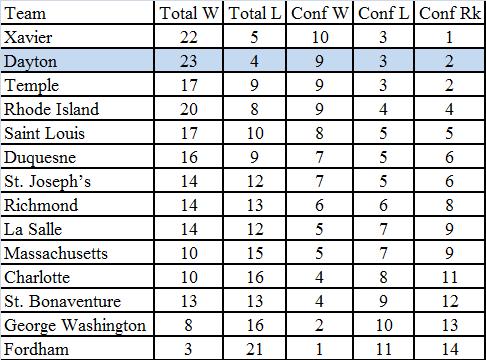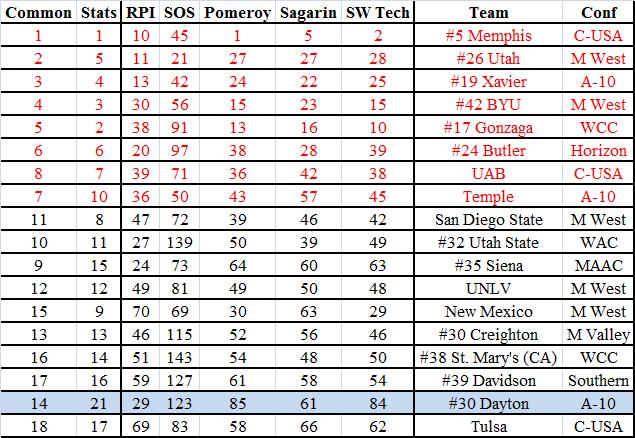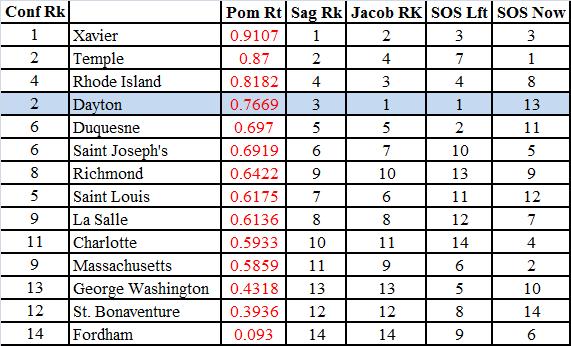Dayton and the NCAA Tournament
Disclaimer: In my information about past mid-major at-large teams, I include their record and RPI ranking in the week before Selection Sunday. As a guide for my readers, here is a list of the college basketball rating Web sites that I use in this article:
Jeff Sagarin’s College Basketball Rankings
Ken Pomeroy’s College Basketball Statistics
The Entropy System Sports Ratings
With only four games remaining in the Atlantic-10 schedule for the Dayton Flyers, I thought it was about time that I wrote a detailed description of how they can possibly advance to the NCAA Tournament in just a few weeks here. Dayton currently sits at #30 in the AP rankings, with a 23-4 overall record, 9-3 in conference play. They had been #25 in this ranking last week, before a surprising loss at Saint Louis brought them back to the “receiving extra votes” category. They have been a good team throughout the season thus far, but these losses to Creighton, Massachusetts, Charlotte and now Saint Louis in the first 27 games could be the main reasons why the NCAA Selection Committee chooses not to include Dayton.
Dayton faces the toughest remaining schedule of any team in the Atlantic-10. They schedule includes a road date with Rhode Island on Wednesday night, a visit from Temple on Saturday, before finishing up with a road trip to Xavier next Thursday and the season finale at UD Arena against Duquesne. In order to understand how difficult these last four games will be, here is a look at the current A-10 standings:
All of these final four teams are above .500 thus far in conference play, and it will probably be rather difficult enough for Dayton to go 3-1 on this final swing, let alone break even at 2-2. Keep in mind, Dayton will be playing the remainder of the season without my favorite player, junior point guard Rob Lowery (7.5 points and 3.4 assists in 18.2 minutes off the bench), who tore a tendon in his knee in the victory over Xavier two weeks ago. If the Dayton Flyers do not win out the remainder of the regular season, they will find themselves among a whole slew of teams vying for spots as mid-major at-large teams in the NCAA Tournament.
In my work on the NCAA Tournament over the past few years, I compiled a list of all of the teams that have ever made the Tournament in the 24-year history of the 64 (or 65)-team bracket formation. In each tournament, the winner of every single conference tournament (except for the Ivy League, which does not have a post-season tournament) advances to the NCAA’s. In addition to these 31 champions, the NCAA Selection Committee must distinguish the 34 other most noteworthy basketball teams in the country to fill at-large bids in the tournament. Here is a breakdown of how these at-large bids have gone to major and mid-major programs in recent years:
It is not a surprise to see that traditionally, teams from major BCS conferences have been in the NCAA Tournament much more frequently than their mid-major counter-parts. In addition, it should not be surprising to see the quartile breakdown of these at-large teams. There have been on average 8.2 mid-major at-large teams in the NCAA Tournament over the last five years (only 6 in each of the last two years), and the majority of these teams have fallen in the range of 7-11 all-time. Every now and then, there are higher extremely high seeds for teams like Xavier, Memphis or the 2004 St. Joseph’s squad featuring Jameer Nelson and Delonte West that went 27-0 in the regular season and then lost in the conference tournament. However, the majority of mid-major teams are lower seeds in the tournament as at-large teams than at-large teams from major conferences.
There are many reasons to explain this discrepancy in the NCAA Tournament, but for the sake of this single article, it is singly important to note that every year there are good mid-major at-large teams that fail to make the NCAA Tournament. Since many major conference schools are able to pad up their strength of schedule, and computer rankings during the regular season, only the very best teams in the mid-major at-large category advance on to the NCAA Tournament. Case in point, here is a sampling of teams the NCAA Selection Committee passed up on in 2007:
RPI #29 Air Force (22-8, 10-6 M West)
RPI #36 Bradley (19-11, 10-8 M Valley)
RPI #37 Missouri State (20-10, 12-6 M Valley)
RPI #40 Drexel (22-8, 13-5 Colonial)
RPI #43 Utah State (20-11, 9-7 WAC)
RPI #60 Massachusetts (23-8, 13-3 Atlantic 10)
This was also the year that the Akron Zips finished 25-7, 13-3, yet failed to make the NIT or NCAA Tournament after losing to Miami University on a last-second three-pointer in the MAC Championship. Then from last season, the second year in a row that only six mid-major at-large teams advanced to the tournament, here are some teams that the Selection Committee passed up:
RPI #32 Dayton (21-10, 8-8 Atlantic 10)
RPI #34 Illinois State (23-9, 13-5 M Valley)
RPI #43 Massachusetts (21-10, 10-6 Atlantic 10)
RPI #46 Creighton (20-10, 10-8 Atlantic 10)
RPI #53 UAB (22-10, 12-4 C-USA)
RPI #56 Virginia Commonwealth (24-7, 15-3 Colonial)
Over the last two seasons, the average RPI of a mid-major team selected for an at-large bid has been about 27.2 with #42 St. Joseph’s of the Atlantic-10 last season the lowest ranked. When you look at the teams that the Selection Committee has passed up on, however, it appears that RPI is clearly not the only ranking or formula that they use. Dayton was from the same conference, and ten spots higher in the RPI than St. Joseph’s last season, yet still did not make the NCAA Tournament. Thus, in my attempt to breakdown the potential mid-major at-large teams for this season, I looked at some of the leading college basketball ratings on the internet in addition to the aging Ratings Pending Index.
With a firm amount of confidence, I can clearly say that Memphis (C-USA), Utah (Mountain West), Xavier (Atlantic-10), BYU (Mountain West) and Gonzaga (WCC) are going to the NCAA Tournament this March. These are without a doubt the top five mid-majors in the nation this season, as all have RPI’s below 40 along with rankings from Pomeroy, Sagarin, and SW Tech all below 28.
My next tier of teams includes Butler (Horizon), Temple (Atlantic-10) and UAB (C-USA). These three teams are clearly behind the top five, but all seem practically assured of an appearance in the NCAA Tournament. These three teams are the only teams to rank in the top ten in both of my two different ranking measurements, one emphasizing RPI, and the other emphasizing the more statistically inclined rankings from Pomeroy, Sagarin and SW Tech. While these teams may still need a few key wins, and a trip to their conference tournament semifinals, they are relative locks assuming their continued stellar play.
As you can see in the table above, the University of Dayton falls towards the end of my next tier of teams, now up to 18 in total. How can this be when they are seventh among mid-majors in RPI, and are #30 in the nation according to the Associated Press? Well, thanks to a SOS (strength of schedule) that ranks 15 among these eighteen teams, and an incredibly unfavorable review from the statisticians, Dayton falls towards the end. While I had previously thought that Dayton was near the top of the list of the mid-major teams in the nation, especially when considering their national rank and RPI spot, I am now thinking twice about that estimate.
Earlier I mentioned that at least six mid-major schools in the top 60 of the RPI did not make it to the NCAA Tournament the past two seasons as at-large teams. While those RPI rankings included conference tournaments, you can firmly assure yourself that six of the teams above, (along with George Mason and Illinois State, who are also in the top 60 of the RPI) will not win their conference tournament and will not advance to the NCAA’s. While one of those teams could easily be a squad like Davidson, that has struggled recently while superstar Stephen Curry recovers from an ankle injury, it could also very easily be Dayton snubbed for the second year ago. The possibilities of Dayton missing the tournament increase when you factor in their upcoming strength of schedule.
The table to the left shows the entire Atlantic-10 as rated by statistical guru Ken Pomeroy. In addition, I also included the conference rankings according to Jeff Sagarin, my rankings largely based on win/loss record and strength of wins, and then their strength of schedule. The first column titled “SOS Lft” shows the remaining rank of difficulty for every single team, and “SOS Now” ranks the teams in order of their difficult schedule played thus far. The SOS measurements average the ratings from the RPI, Pomeroy, Sagarin, SW Tech and my formula to come up with a rough estimate of how difficult the schedule ahead is for these teams.
Dayton clearly has the most difficult schedule remaining of any Atlantic-10 team. The surprising Duquesne Dukes have the second most difficult schedule, yet they only host Richmond and Saint Louis, and travel to Massachusetts and Dayton. There is no doubt that the future of Dayton’s NCAA Tournament hopes firmly rely upon how they finish out the season here in 2009. Here is a look at what I think the Flyers will need to do in order to make the tournament:
· Finish regular season 3-1 or better (loss being to Xavier) and make semifinals of A-10 Tournament
· Finish regular season 2-2 or better (one loss being to Xavier) and make finals of A-10 Tournament
If the Flyers can pull one of those two conclusions to the regular season, they will have proved that they belong in the NCAA Tournament. Over the last fifteen years, an average of 2.8 teams from the Atlantic-10 advanced to the NCAA Tournament, and only in 2002 and 2005 did the tournament champion advance. With Xavier clearly established as one of the top mid-majors in the country, and Temple, St. Joseph’s and now Dayton all clearly in the top thirty or so this season, it seems as if this is a prime year for two or three bids. As long as the Flyers can maintain the intensity they had in their win over Xavier two weeks ago, I clearly expect them to finish with a good enough mark to make the NCAA Tournament.
*UPDATE as of 12:56 AM Thursday, February 26*
The Dayton Flyers just fell to the Rhode Island Rams 93-91 in overtime. Chris Wright fouled out in the extra period, but more interestingly, Chris Johnson did not play in this game for the Dayton Flyers. I am not immediately aware if the superb freshman was injured or not, but it got me thinking as to what the Flyers have done when he is not on the court this season. In fact, when looking at his game log this season, he has only not registered a point in five of our 28 games. In these five games, the Flyers have either lost (to Creighton, St. Louis or Rhode Island) or win very close, defensive battles with small margins of victories (3-point win over Wofford and 5-point win over Miami OH).
In fact, when you split up the season exactly in half, you can see that Chris Johnson has scored more than 5 points in 14 games, and 5 points or less in 14 games. In the 14 games when he scored 5 points or less, the Flyers have averaged an average scoring differential of +3.5 (63.79 to 60.29) and in all of the other games, they have averaged a scoring differential of +11.0 (71.21 to 60.21). These are some pretty impressive split statistics, and they actually follow through pretty similarly in terms of his minutes played. He has 3 games with exactly 18 minutes played, and then 13 with less than 18, and 12 with more than 18. Averaging out the 18 minutes played games, and assigning one such game to the less than 18 column, and two to the more than 18 column, you can break down the differentials. In this instance, the scoring differential increases from +5.21 to +9.29 in the top half of Johnson’s games.
Thus, it is rather clear that freshman forward Chris Johnson is a vital addition to the Dayton Flyers this season. With him, they are a much better team capable of breaking the bank as a mid-major at-large team in the NCAA Tournament. Without him, as proved in the last two road losses, the Flyers are no better than a middle-of-the-road team in the conference still unable to win a big road game. Whatever is ailing CJ, I hope it is fixed up soon as he is a huge part of this team this season. His playing time and production on the court and clearly related to the Flyers’ success, and I hope that he can see his production continue throughout the rest of his Flyers career.




Very Nice Blog.. with my best wishes.
HAZEM
http://www.jordan4ever.com/LiveTv/
Comment by HAZEM | March 6, 2009 |